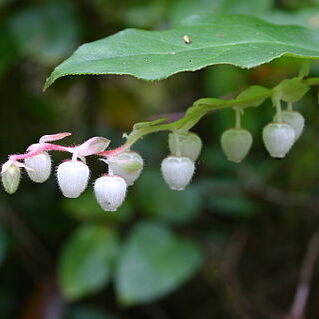Shrubs or subshrubs, (sometimes rhizomatous or stoloniferous and rooting at nodes). Stems erect or procumbent; twigs glabrous or hairy. Leaves persistent, aromatic; blade ovate, elliptic, or orbiculate to subcordate or reniform, coriaceous, margins serrate, crenate, or ciliate, plane or revolute, surfaces glabrous or hairy; venation reticulodromous or brochidodromous. Inflorescences axillary, racemes, 2-12-flowered, sometimes flowers solitary; (bracteoles closely subtending flowers). Flowers: sepals (4-)5, connate basally to nearly their entire lengths, (sometimes exceeding petals), ovate, deltate, or cordate; petals (4-)5, connate ca. 1/2 to nearly their entire lengths, white or cream to pink, corolla urceolate to campanulate, lobes much shorter than tube; stamens 8 or 10, included, (inserted at base of ovary); filaments straight, flattened, usually widest proximally, glabrous or hairy, sometimes papillose, without spurs; anthers with 2-4 awns or without awns, dehiscent by pores with ventral slits, (white disintegration tissue present dorsally along connective); pistil 4-5-carpellate; ovary 5-locular; stigma truncate or capitate. Fruits capsular, 5-valved, globose, fleshy, (surrounded by persistent, fleshy calyx). Seeds 20-80+, ovoid; testa smooth. x = 11, 12, 13.
Upright terrestrial or epiphytic shrubs, prostrate undershrubs or rarely small trees. Leaves persistent, short petiolate, usually serrate, pinnately veined. Inflorescences terminal panicles, axillary racemes or rarely solitary in the axils of the leaves; pedicels clearly articulated or jointed below the flower; bracteoles 2 or several, basal, medial or closely subtending the pedicels. Flowers with the calyx (4)5-parted, usually accrescent and becoming somewhat fleshy; corolla campanulate to urceolate, white to pinkish or reddish; stamens (8)10, the filaments distinct, basally expanded, borne on the base of the corolla, the anthers with white tissue on the abaxial side and often with 2, ascendent, terminal awns on each anther sac which open introrsely by a single apical pore; stigma obtuse or truncate, the style straight, the ovary superior or rarely partly inferior, (4)5-locular, ovules 5-10 (or many). Fruit a (4)5-valved, loculicidal capsule en-closed by the usually colored, slightly to conspicuously fleshy calyx and thus sometimes appearing superficially berrylike; seeds usually numerous, small, an-gled, and wingless.
Shrubs evergreen. Stems erect, creeping, or procumbent. Leaves spirally arranged, petiolate; leaf blade serrate or rarely entire. Flower usually 5-merous, sometimes 4-merous, in axillary or terminal racemes or panicles, or solitary; bracteoles variable in position. Calyx deeply divided. Corolla usually white, urceolate, campanulate, or tubular, shallowly lobed. Stamens included; filaments flattened, usually dilated towards base; anthers oblong, dehiscing by terminal pores, with 2–4 awns or minute projections. Ovary superior or semi-inferior, with many ovules per locule. Stigma truncate. Calyx at fruiting accrescent, fleshy; capsule dehiscing loculicidally or sometimes irregularly [fruit a berry]. Seeds small, unwinged.
Fls 4–5-merous; cal closely subtended by 2 bracteoles, campanulate to saucer-shaped, deeply divided; cor tubular to campanulate, shallowly lobed; stamens included; filaments short, flat; anthers oblong, the pollen-sacs separate or nearly so, each tipped by 2 erect awns; ovary 4–5-locular, wholly or partly superior; style short, columnar; stigma truncate; capsule thin-walled, completely enclosed in the fleshy, white or colored, accrescent cal, forming a dry or mealy berry-like fr with a characteristic flavor; erect to creeping shrubs with alternate, persistent lvs and usually white fls in racemes or panicles or (in our spp.) solitary in or just above the axils. 150, widespread.
Evergreen, erect or prostrate shrubs, occasionally tree-like. Lvs usually alternate, rarely opposite, usually toothed; petiole short or occasionally 0. Fls in terminal or axillary racemes or panicles, less commonly solitary, (4)-5-merous, pedicellate, with bracts and bracteoles. Calyx lobed, usually deeply so, accrescent. Corolla lobed, urceolate to campanulate. Stamens 10, included; anthers with 2 or 4 awns or obtuse. Disc 10-lobed. Ovary glabrous. Fr. a 5-valved capsule invested by enlarged and fleshy calyx and thus berry-like, rarely calyx persistent but dry (5 N.Z. spp.). Seeds numerous, minute.
Calyx 5-lobed, persistent; corolla 5-lobed, urceolate to campanulate, with 5 imbricate lobes. Stamens 10; anthers 2-celled, not exserted, dehiscing by pores, each cell tipped by 2 erect awns; filaments ± dilated at base. Ovary 5-loculed, style cylindric, stigma simple. Capsule loculicidally dehiscent, often invested by enlarged and succulent calyx; seeds ∞, minute. Widespread genus with c. 120 spp., mostly shrubs. The N.Z. spp. endemic, except G. depressa, which occurs in Tasmania.

